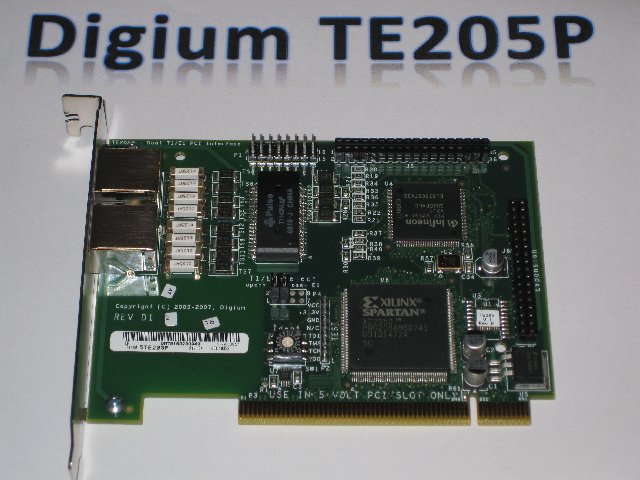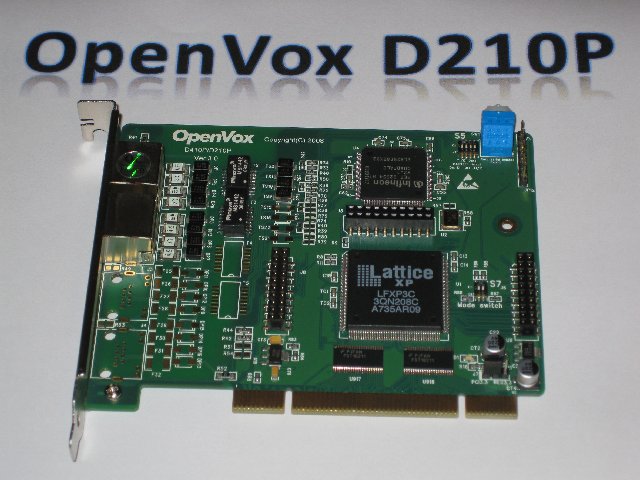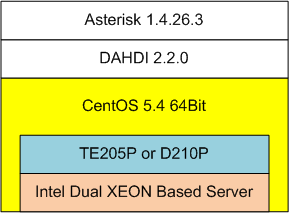If there is one thing I like doing is testing hardware, specifically, testing new hardware that is related to Asterisk. I was more than pleased when OpenVox had approached me, asking to review one of their products – specifically after I once announced that I really dislike cheap clone cards. So, I got OpenVox’s D210P card, which is a fairly similar clone to the TE205/TE210 of Digium, and I decided to take a it for a test drive.
So, first off, lets take a look at Digium’s TE205 card:

The card is based upon two specific chips, the Xilinx Spartan FPGA and an Inifineon based Quad E1/T1/J1 framer chip. Technically speaking, the entire brain of the outfit is located in the Xilinx FPGA (naturally), which on the TE205P now enables remote firmware upgrades and some additional features. Digium had been using Xilinx based boards for over 8 years now, and they’ve been doing the job more than well.
Now, let’s take a look at the OpenVox clone board:

The Test Scenario and Comparison
All of the above tests were conducted according to the following scenario:

In general, I’ve connected 3 different IP phones to the testing server: A Polycom 650, a SNOM 370 and a Grandstream GXP2000. All IP phones include the latest firmwares and updates and were all working flawlessly with another similar setup, so I assumed they were all bug and issue free for the testing lab. The main reason I’m using 64Bit CentOS is simply due to the fact that all my servers are 64Bit capable (mainly E5410 and E5405).
Test 1: Normal Telephony
Well, in general, the card does exactly what it should – provides a connection to an E1 circuit (we only have E1 circuits in Israel). I’ve conducted normal telephony functions from all the above mentioned phones. In general, I’ve conduct from each phone a total of 40 calls, and repeated the test once for the Digium TE205P card and once for the OpenVox D210P card. The results were fairly similar with a slight advantage for Digium. In general, the OpenVox card had slipped about 4% of the calls, mainly to an IRQ miss that occurred for some reason. With the Digium card, the IRQ misses were not exhibited, allowing for all 120 calls to traverse normally.
Conclusion: In a normal office telephony scenario, the D210P is a fair choice – however, not my preference for a Call Center or a service provider.
Test 2: 3G based transmission (64kbps bearer capability)
I’ve been playing around with IVVR and Asterisk, mainly using the Fontventa H264 packages for Asterisk (that’s why I used 1.4 branch). With this test, the D210P provided less then medium results, specifically when trying to stream large 3gpp based video streams, while the TE205P had showed no specific issue with the transmission. Main issues exhibited were related to choppy video streams, causing jumps in the stream. The Digium card was fully capable of stream the video without a hitch. Now, I won’t hold this again OpenVox, as this usage is fairly advanced and is required by a very small portion of the market, but I believe they still have some work to do there. As they are using the same framer as Digium, I would deduce that their firmware is either an older import from Digium (reverse engineer) or some other firmware related issue.
Conclusion: Not a pick for 3G transmission with Asterisk.
Test 3: Dropped calls during high loads
No matter what test I did, with OpenVox I’ve always received a dropped call ratio of around 3-4% – when at high loads that went up to around 7%. When I mean high loads, I mean generating 30 outbound calls from Asterisk to one circuit, then receiving them on the second port (yes, a back-loop). I’ve conducted 100 runs of this test, at various speeds. It would appear that when generating calls with a 100ms interval between one initiation to another on the circuit, the OpenVox will drop a call here and there – at sporadic intervals. This may be actually related to the IRQ misses exhibited in Test 1.
Conclusion: If you have high load anticipated – OpenVox is not the choice for you.
Test 4: CPU Load/Spikes
It is a well known fact that all card that are used with Asterisk introduce load spikes of a sporadic nature. In the past, the masters of low spikes were Sangoma, however, with the introduction of Digium’s VoiceBus, that balance had tipped and Digium took the upper hand. In order to evaluate the spikes, I’ve monitor the machines’ load while having 30 calls traverse from one port to the other. The calls were playing back a static file of 5 minutes, and after disconnecting the calls would generate and additional one and continue from there. Both cards exhibited slight spikes when multiple calls either originate or disconnect, however, the CPU spikes that the OpenVox card had exhibited were about 40% higher than the ones exhibited by Digium and there were more spikes than with Digium.
Conclusion: If your system isn’t as beefy as mine, and you need full capacity – OpenVox isn’t the choice for you
Overall Operational Conclusion
The OpenVox card promises to be a low-cost alternative to the Digium card, and it surely delivers. Over all, if you have an office PBX system or a low scale IVR environment, the OpenVox alternative can be evaluated, although it’s not my personal favorite. Sure, in many cases I can say: “OpenVox would do the job” – but hey, I would always rather go with the original and not the clone. I believe that OpenVox are far ahead of its clone competitors (Atcom, Yeastar, Varion, PhonicEQ, etc), simply because it does a better job at building and designing a better card – however, they still have some way to go in order to be completely in-lined with Digium and Sangoma.
![Reblog this post [with Zemanta]](http://img.zemanta.com/reblog_e.png?x-id=89a56920-a776-4d72-a7a3-127146e056df)